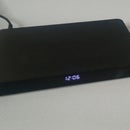Introduction: Minimalistic Led Clock
In this instructables, I will show you how to make a simple/minimalistic led clock.
The clock shows 3 dots.
One from the seconds (blue), one for the minutes (yellow) and one for the hours (red).
Let's get started!
Step 1: Parts
For this clock, you'll need several parts. These are:
- An arduino nano
- A 60 led ring (seconds/ minutes)
- A 24 led ring (hours)
- A DS1307 RTC (for keeping time)
- Some wire, I recommend white single core wire
Step 2: Schematic
This project has pretty simple wiring.
First you connect both rings after each other.
Then you connect the input of the rings to pin D9 on the arduino.
After that, you can connect the RTC to the arduino on pins A4, A5 and D2.
Step 3: Clock Overlay
I made a pretty basic layout, which fits the led rings.
I printed it on heavy paper, so the leds aren't that bright.
After you printed it, just cut out the circles and its ready to use.
Step 4: Code
In the code, I used 2 libraries.
The first one is the adafruit Neopixel library
And the second one is the RTClib
To set the time, connect the arduino to the computer and open clock.exe in clock.rar.
It will show all com ports available and ask you which port you want to use. Just type "COM0" where 0 is the number you want. The script should automatically update the time of the RTC using the time off your computer.
Step 5: Resume
That's it, now you have a simple led clock.
I hope you liked it and you are able to recreate it yourself.





